Digital Cables compared – AES/EBU, Coax,Toslink and ST Glass
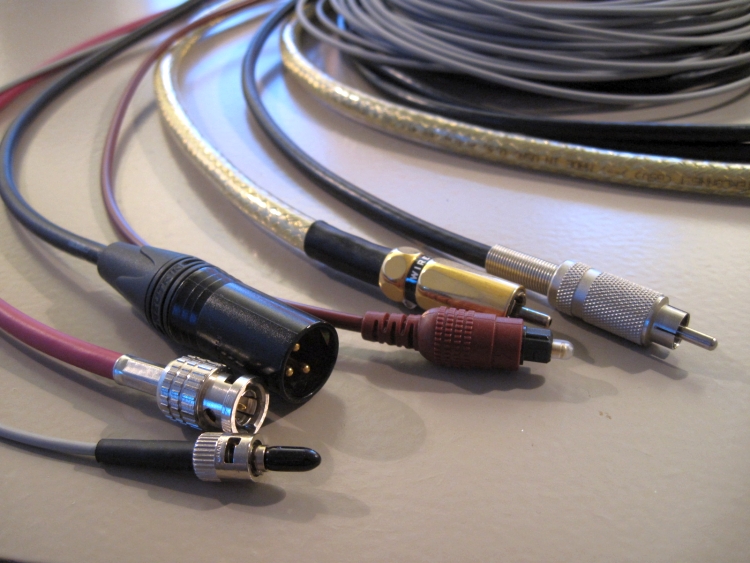
Do digital cables really make a difference in sound? And if so, what are the differences?
Skeptics and die-hard technicians claim that differences in sound are impossible with digital cables, as long as the receiving device re-clocks the signal. Well, I have experimented with many different DA converters of all sorts, entry-level consumer, pro audio, and super high-end, that have reclocking, resampling, extra RAM or a combination of techniques and I haven’t come across a single DAC that does not sound different depending on the source or cable.
I haven’t based this on only a few digital components but have tested many: Mark Levinson no.36, no.360S and 390S, Wadia 12, 25 ,27ix GNS, 861, dCS Delius/Purcell, Krell KPS20i, Weiss DAC2, Ayre QB9, Arcam rDAC, DAD AX24, Meridian, Audiomeca, Audio Aero and many more. All these DACs and CD players showed comparable differences between digital cables used. I have also tested many digital cables, too many even to mention here.
Firstly, I have to mention that normal people (not obsessive audiophiles:-) would probably categorize the differences between cables I am talking about as nuances. I do feel however that these nuances can mean a lot in a well-balanced high-end setup. Even if you’re not looking to squeeze the last drop of quality from your system it may still be interesting to note that differences can be heard even though simplified conventional wisdom may dictate that it should not be possible. Finally, I should note that not all components are sensitive to cable influences in the same measure. Some are so impervious to make the differences pretty much meaningless.
DIGITAL SIGNAL TRANSMISSION
My personal concern is not so much the technical background but rather the audible differences themselves. Nevertheless, below I have copied a section from the CH Precision website to help illustrate why cables can indeed influence the quality of digital transmission.
“Digital signal’s quality is too often overlooked by simplistic statements such as “It is digital therefore it is perfect”. This is true as long as we stay in the digital domain. But there are two main cases where it is no more true: when a digital-to-analog (D/A) or an analog-to-digital (A/D) conversion takes place and when several digital devices need to be synchronized. In these cases, extreme care must be taken to digital (especially clock) signal’s quality, more precisely to their perfect timing (edge shape and time-placement accuracy). There are several ways to synchronize a digital source and a DAC. The most common ones include analog Phase-Locked Loop (PLL), asynchronous Sample Rate Converters (SRC) and First-In-First-Out (FIFO) buffers. Each of these techniques has its own advantages, but also its own drawbacks.”
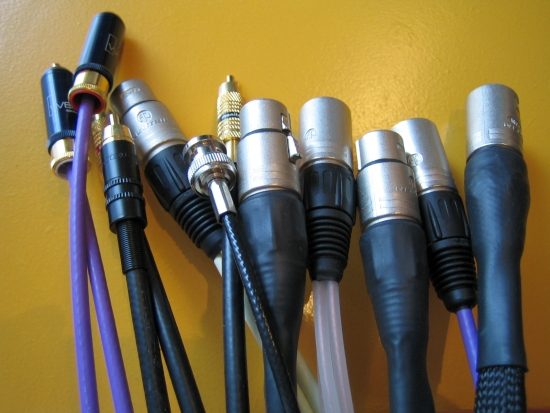
WHAT ARE THE AUDIBLE DIFFERENCES?
The most prominent differences are known as PRAT. PRAT stands for pace, rhythm, and timing. In layman’s terms, this means temporal changes rather than tonal. I have also noted tonal differences between digital cables but for these differences, you need to audition two very different cables. For example an Apogee Wyde Eye and Belden RG59. In that case, you’re comparing solid core in a tight sleeve to litze in a very flexible sleeve. If you compare cables that are more alike, as is usually the case, the cables more or less resemble each other in tonality. And then it is easy to say that the cables sound alike. But listen more closely and you’ll find that one cable can sound slower and more rounded than another that is sounding faster and more dynamic.
The more you listen for differences in cables the better you learn to listen beyond the generic “sound” of a cable. There will appear to be more subtle changes such as fluidity in the treble, fullness of bass or lack thereof, overall warmth, decay of subtle sounds and tightness of attack in transients. The more careful you listen, the more you’ll hear.
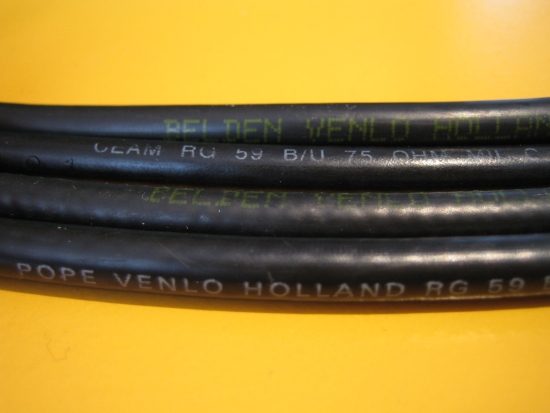
three of these cables are of the RG-59 type, and so should adhere to strict specs, yet they all sound different. The fourth cable (with the tinned shielding) is a special double-shielded variant for higher-spec video use over long distances or in signal unfriendly environments.
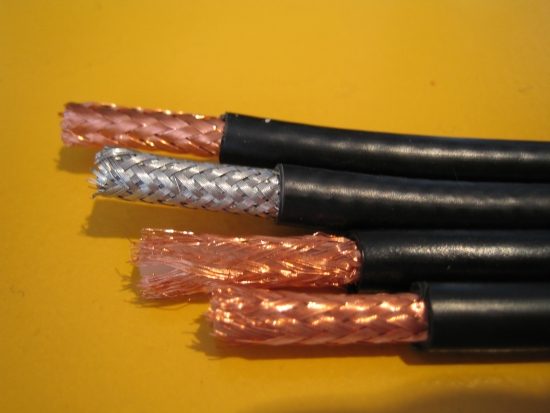
RG59 COAX
This may sound incredible, and I know that many technicians would declare me crazy but I’ve listened to every RG59 coaxial cable I could lay hands on and I can tell you that there are large differences between the various brands. Even going from one Belden type to the next, there are big differences. The differences in sound are not usually timbral in nature and hardly concern detailing but can best be described as changes in transient sharpness which is related to the perceived speed and the sense of warmth. One cable can be very fast and dynamic sounding while another can sound slow and overly smooth.
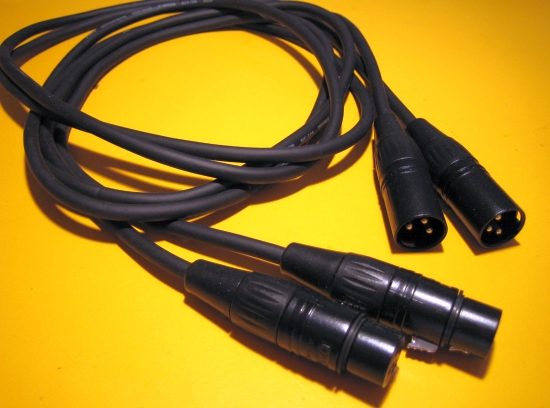
WHAT ABOUT AES/EBU?
AES/EBU is a professional standard and although it can run over a coax cable, and the AES flag can be either on or off, the native format of the signal is balanced and thus it is meant to run over a balanced. The format is intended not to sound better (as many audiophiles assume) but to be more solid over great lengths and under harsh conditions. For instance, in recording studios and post-production facilities where there can be enormous lengths of cable between any two components and 100 meters is not uncommon. This is where the balanced signal comes into play. Just like with balanced analog signals, in the digital form, there is a plus and minus side which are in opposite phase to each other. Any disturbance picked up by the cable is likely to be present in both positive and negative conductors. A phase comparator in the component at the receiving end subtracts both signals and consequently gets rid of the disturbance. This is possible because the disturbance will be in phase on both conductors while the music signals are in counter phase.
For this to work, a source needs to present the digital data to the output in balanced form. Some components use true differential circuitry but most convert the single-ended signal to a balanced form by means of active circuitry or transformers. One could imagine that any extra processing going on can have a negative effect on the sound. But whether this is the real culprit or it is another factor, there’s something to AES/EBU that makes it sound different from SPDIF. And it’s not only the cable, either. I’ve tested many, and have also used AES inputs and outputs with coax cable in balanced and unbalanced form. In all cases, the AES input sounded different from the SPDIF coax input.
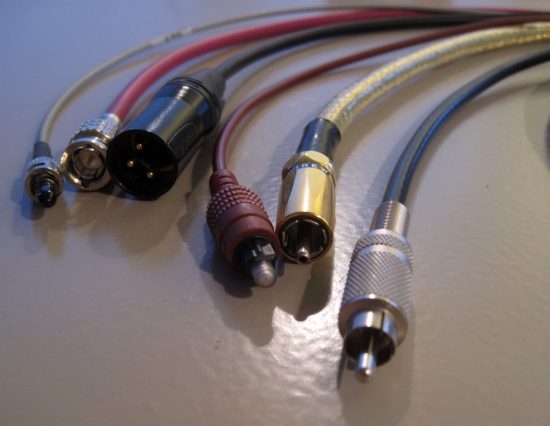
WHAT ARE THE DIFFERENCES IN SOUND BETWEEN S/PDIF AND AES/EBU?
Under most circumstances where I tested this, I find AES/EBU to sound overly controlled or restrained and typically a little too clean. And perhaps because of its very tidy sound, AES/EBU often fails to excite me. The bass is clean and articulated and technically probably precise but via SPDIF, the bass is more solid, bigger and more physical. Of course, opinions will always vary and you may well actually prefer AES/EBU over coaxial. That’s all fine. This article is merely meant to raise awareness of the fact that there are differences and AES/EBU need not automatically achieve the best balance.
The good thing is that the differences in cables are a little less clear with AES/EBU than they are with SPDIF and even very standard cables can do very well.
Update 2017: with the Aurender N10 connected to a Wadia 521 and many other DACs I now find that coax and AES/EBU are much closer to each other in sound than I have heard before.
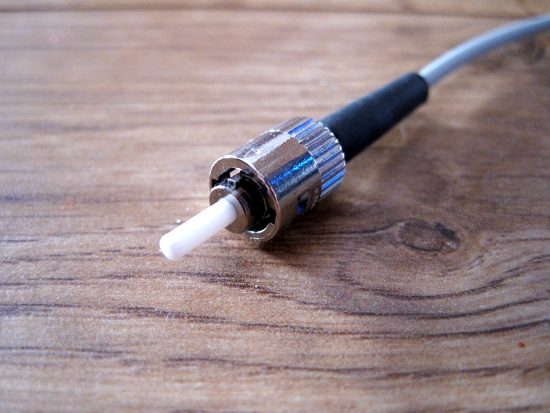
ST GLASS VERSUS TOSLINK
This is (in the audiophile world) an old standard by now. It comes from the telecom world and is still used there extensively. Unfortunately, not many manufacturers of audio equipment today use this standard. An exception is M2Tech with its HiFace EVO USB interface. This little unit actually allowed me to compare a 25 meter long Belden RG59 coaxial cable to the same length ST glass cable directly into the Levinson no.360S DAC. ST Glass transmission is optical but don’t confuse it with Toslink. First, there is a laser, not a LED in the transmitter, second, the conductor itself is made from very thin glass, not plastic. Lastly, the wavelength is very much higher and is wholly appropriate, even oversized, for consumer digital audio whereas Toslink is actually underspecified. Toslink connections tend to soften transients and lessen dynamic behavior compared to an electrical connection. This isn’t the case with ST glass. Instead, the musical portrayal is very much as dynamic and speedy as with RG59 but devoid of the added sharpness and “zing” of the latter cable. At the same time, ST Glass is more detailed and refined than RG59. Do note that in certain system setups, RG59 might sound subjectively better just because of its more aggressive character. ST Glass is so much so devoid of artificial sharpness that it may appear to “rock” less. In my setup (Jeff Rowland and Magnepan speakers) I prefer ST glass, especially since I need to use a very long 25-meter cable. Whether or not ST glass is better for you too, depends on your setup and your taste. Toslink, however, is always the lesser choice, unless you have a setup that is perhaps somewhat edgy and overaggressive, in which case Toslink might soften things up a bit. But this will be at the expense of some dynamics and speed. The other good thing about ST glass is that it is designed for long distances. And by that, I mean hundreds of meters. I have yet to do the actual comparison (and will do of course) but in theory, a length of 25 meters sounds the same a length of 1 meter. From what I gather in my 25-meter cable comparison, I have no reason to doubt this. The ST Glass cable I tested was a standard no-name cable that cost less than 40 us dollars for 25 meters. That’s even cheaper than Belden RG59!
ADAPTERS
BNC to cinch adapters are cheap and handy and seem to do their job just fine. However, when you start comparing, it becomes obvious that these adapters do add some edge to the sound and depending on your system’s balance and your own sensitivity to this, are best avoided. For example, when using equipment having both BNC and cinch inputs and outputs, Belden RG59 with crimped on BNC connectors has a nicely neutral, yet dynamic and lively character with excellent focus, drive, and attack. When comparing to the same cable with cinch connectors and BNC adapters, you notice that the resultant sound is more “impressive”, with more presence in the treble and seemingly more attack. But you quickly realize that this also makes the cable sound a bit aggressive and unnatural. In overly smooth setups, however, this can give some nice extra “bite” to the sound.

BNC VERSUS COAX
Some components offer both Cinch and BNC connections for SPDIF. In the cases where I have compared these outputs, usually, BNC sounds cleaner with sharper focus. This makes sense because it is technically also supposed to be the best connection. However, depending on circumstances you may also prefer the cinch outputs because these tend to sound beefier in the bass and arguably a little more colorful.
Update September 2020
Having reviewed the Jorma AES/EBU cable has turned some of my long-standing views on the subject upside down. It’s not just the cable, though, but also my preferences that have changed over time, along with system changes. Overall, my current view is that any connection can sound good or not so good, depending on the quality of the cables and the implementation of the interfaces. Please read the review for more info.
Read Also
Belden, Mogami, Wireworld and Transparent Digital Audio Cables Compared
Digital Cables compared – USB and Ethernet
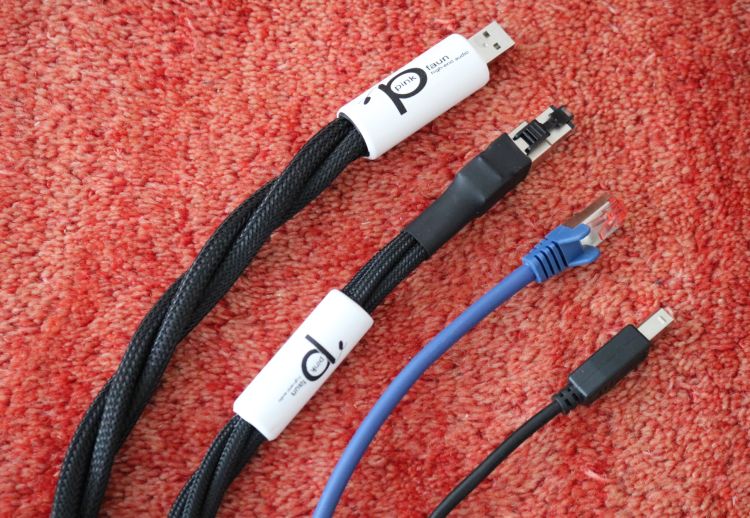
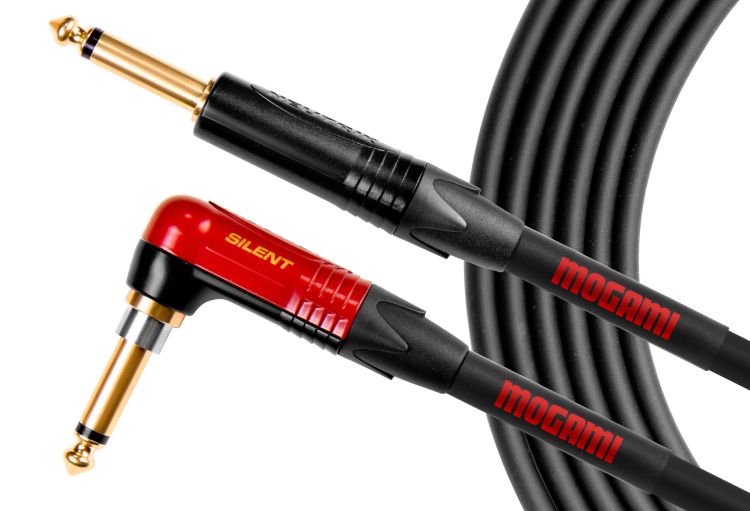
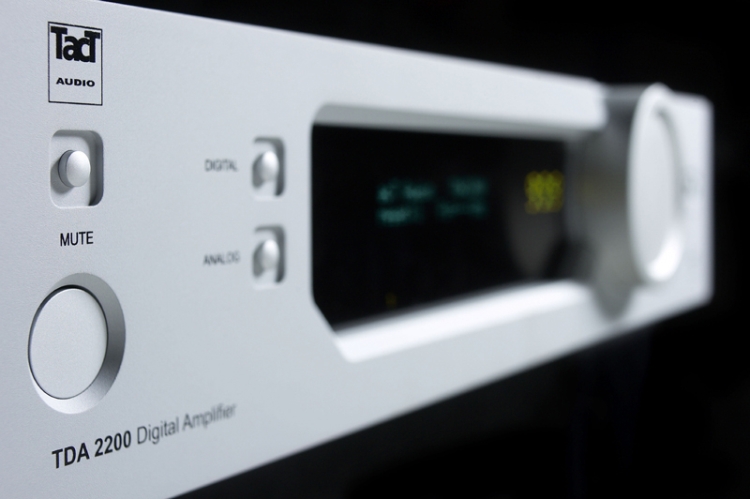

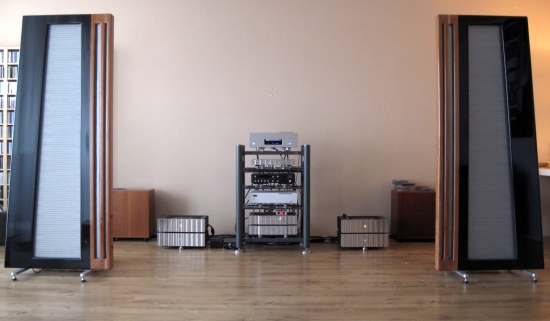
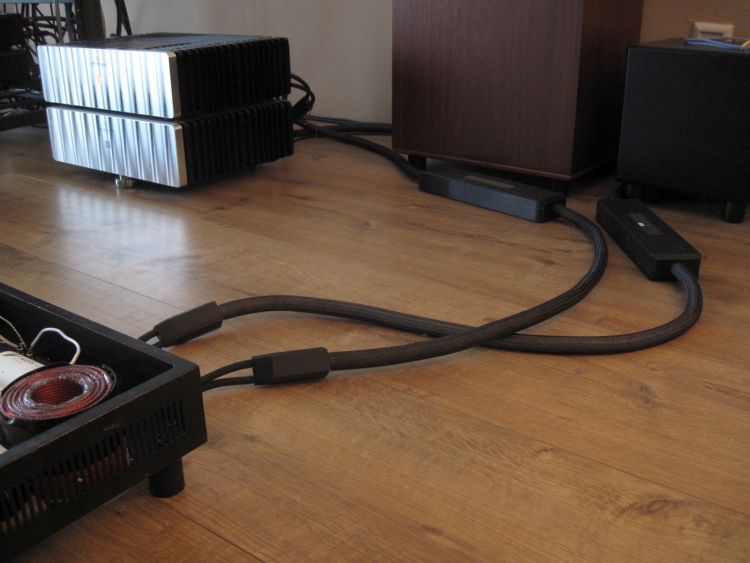

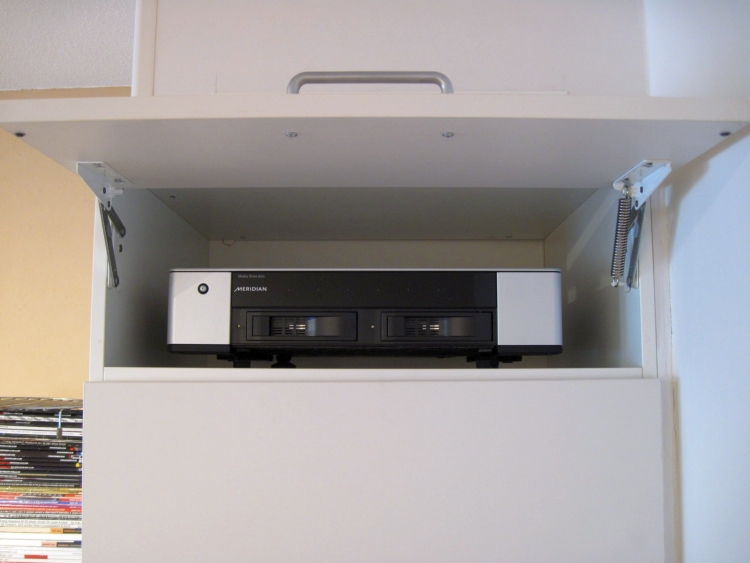
Fantastic article/review ! Very nicely (and professionally) done.
peter jasz
Hi Chritian: I actually wrote a lonfg reply/comment, but lost it due to the “Name/I’m a Robot” thing.
Anyway, a really impressive read –much time and effort went in to it. And excellent, interesting obbservations revealed.
Really nicely done.
Only one observation –and it is this:
You quote: “Firstly, I have to mention that normal people (not audiophiles) would probably categorize the differences between cables I am talking about as nuances.
(Yes, and same folk would same same comparng Toyota to Porshe)
…. “I do feel however that these nuances can mean a lot in a well-balanced highend setup.”
(Absolutely can and does impact performance/sound very significantly! And not necessarliy a “high-end” system is required for readily apparent improvements to be recognized –and immensely enjoyed.)
Great work !
peter jasz
This article is utter nonsense written by a technical ignoramus. The only redeeming quality is that any self respecting EE will get a good laugh out of it. This is a digital signal, if all the bits get through uncorrupted, then the cable or fiber cannot make any difference at all.
The problem with the bits are bits argument, is you also have to look at the data stream in the context of the electrical system it’s contained within – specifically if a digital to analog converter is in the system. Electrical noise can couple into the DACs ground plain causing intermodulation distortion – which accounts for a lot of the differences in sound. Thus, noise doesn’t have to interrupt the bit stream to have a deleterious effect – but even small amounts can cause audible changes when d/a conversion is involved. Some of HiFi is snake oil – not all of it
Why don’t you get a life and refrain from anonymously calling people names on their blog. Also because you really have no idea what you are talking about.
You were not there with Mr. Punter, so you are just guessing. He is telling us what he heard by doing several comparisons. You are telling us what you did not hear.
Mr. Punter’s description of the different types of cables, was quite informative, also.
Hi,I am very happy with the St cable from my ML 31.5 transport to California Audio labs Alpha dac.
My que is,can we use st cables in between toslink connectors,using st to toslink adaptors if there are any?
AFAIK there are no adaptors and that makes sense because the formats are not compatible. One uses laser and the other LED and at very different wavelengths. There are TOSLink cables made from glass, as opposed to plastic, and these tend to perform better. But ST Glass remains a superior connection.
I posted earlier regarding page 3 of the Wattson DAC review, which features this specific ultra-thin coaxial SPDIF cable. I’ve noticed it appearing in several DAC and streamer review pictures (usually in rear-view shots with cables attached), but there’s rarely any technical information provided about it.
Since the Wattson DAC is classified under SPDIF DACs, it would be great to include information about this SPDIF cable, as it seems like an important detail. Could you provide any insights on this specific SPDIF cable featured in the review, or a link maybe?
Hi Paul, Those ultra-thin coax cables you are referring to are branded “Bastei” and they come with the Silent Angel Genesis GX clock. They are intended as clock cables to feed other Silent Angel components like the Bonn NX, but as I found, they also work well as S/PDIF cables. In that capacity, they sound subtly tighter and cleaner than my trusty old favorite Belden RG59. As far as I know, these cables are not available separately, so there is no point in mentioning them in reviews. I could not use the Bastei cables with the Wattsons as they are too short (the photo where it is connected was just for illustration purposes). Hence, the Belden RG59 cables were put back into service, and I have to say they still sound quite good, although the can be improved upon in certain areas, by higher end alternatives.
Hi Christiaan,
Reading through these pages, while informative, feels a bit like revisiting earlier debates. However, it’s always valuable to reconsider these topics.
I’m familiar with the Bastei as a decent choice for DC power cables, with its variations in copper, silver, or mixed wiring for each polarity. Do you happen to know if the Bastei clock cables are also available in a silver variant?
This isn’t meant as criticism, but I was a bit surprised to see you mention using the “good old” Belden SPDIF or a clock cable you had on hand, rather than, for example, trying a Shunyata or Jorma Digital. Given your positive experience with the Jorma AES/EBU, I wonder if that might have been worth exploring. That said, your earlier reservations about AES/EBU—mentioned above—seem to have evolved over time.
Of course, I fully understand that your schedule is packed, so evaluating “other high-end alternatives” isn’t always possible. The point about length being the limiting factor is especially interesting—something I hadn’t considered, and even more critical for i2s connections (cables).
This comment is purely out of curiosity and admiration for your thorough approach—after all, as audiophiles, we can’t NOT hear the influence of a cable!
Looking forward to more of your fantastic reviews!
Hi Paul, All I know of the Bastei cables is that they came with the Silent Angel Clock. As USB was the leading format for a long time, I have reviewed many USB cables and less S/PDIF cables indeed. Being market-driven, these simply did not come up for review very often. However, I have listened to many brands for my personal use. To my ears, very nearly all digital cables I tried smoothen or otherwise “beautify” the sound, thereby deviating from the kind of honest neutrality that I look for these days, which is why I like to use no-nonsense cables. I think it is fair to say that my taste has also developed throughout the years. 20 years ago, I loved smooth-sounding equipment and cables, but these days, I look for the best articulation and transient behavior I can get, as that is what represents real music for me. Of course, for others, that may be harmonics, fluidity, or other aspects. Reproduction is just not perfect and so we have to focus on the areas that translate the feeling of real live music best to us, individually. Indeed, I have grown to prefer the precision of AES/EBU using a good cable such as the Mogami over the larger apparent dynamic slam using a coaxial cable such as the Belden RG59. My point about length is not that it would be an issue for signal tranfer, but a prohibitive factor with many high-end cables that are already costly at 50 cm or 1 meter, and become arguably too expensive at the 3-m lengths I need.
Thanks for your reply! Regarding cable length, I had understood it was due to the devices being too far apart in your setup. Appreciate your insights!
One of the major points of transmitting signals digitally is the binary nature of signal integrity. Either your signal gets through all bits, clocks, time frame jitter, etc. at sufficient amplitude or it doesn’t. There are no relevant intermediate distortion states, unlike analog. A REALLY bad digital cable will corrupt the signal essentially beyond recognition. All this discussion of musicality and applying analog concepts to a digital signal is B.S. If the signal gets through then the cable is good enough, and you can’t hear the difference.
Thank you for your input. However, your perspective doesn’t contribute meaningfully to the discussion. While the binary nature of digital signals is understood, dismissing nuanced discussions about the audible impact of cables and clocks as “B.S.” shuts down meaningful dialogue.
This forum values respectful exchanges and exploration of such topics. If this approach doesn’t resonate with you, I kindly ask that you avoid these discussions. Constructive input is welcome, but blanket dismissals derail valuable conversations.
I appreciate Paul’s response to Neil. I select my cables based on how they influence the sound, and this includes USB, AES/EBU and even DC cables connecting outboard power supplies. They affect audio and video.
As a professional electronics engineer and plasma physicist working on audio and video and even RF and microwave frequencies, I can tell you that once you get en error free digital signal through your transmission chain, and as long as you are not relying on it for timing jitter (that’s what TBCs are for) it does not matter what your transmission components consist of. The cables do not influence the sound if they do not corrupt the digital signal transmission, end of story. I have been engaged in this debate since 1976 (mostly analog and phase shift then). Nothing has changed.
Neil,
The influence of cables on sound divides opinion, but dismissing it as nonsense without any firsthand experience shows a lack of curiosity and respect for differing perspectives. Many of us who have tested cables extensively know the improvements they can bring to a system. Just because these differences may not be easily measurable doesn’t mean they aren’t real or significant.
If you haven’t tried it or failed to hear it, that’s fine—but making blanket statements or throwing around insults contributes nothing to the discussion. This space is for serious enthusiasts who are willing to explore and share insights. If you’re not open to that, it’s better to refrain from commenting.
I’ve done lots of listening tests on my own and with other A/V enthusiasts.
Cables do make a significant difference, and the practice does take patience and system matching. This is the reason there are so many brands and interesting designs on the market today.